The Tyme Appointed
By Mary Miley Theobald
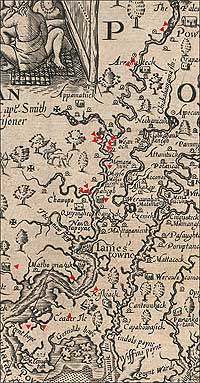
The approximate locations of twenty-one of the English settlements or houses attacked by the Powhatans in 1622 are indicated on this James River Valley- extract of Virginia map produced by Captain John Smith a decade before. Ten other sites, listed in the records as vaguely as "at another place," could not be readily defined. At the top, which is west, are outposts near modern Richmond. At the bottom, which is east, are plantations near modern Newport News. Jamestown stands more or less in the middle on the river's north shore.
The morning of March 22, 1622, Virginia's Powhatan Indian alliance executed a well-conceived and coordinated attack on English settlements spread more than fifty miles up and down the James River. Warriors from perhaps a dozen of the thirty-two affiliated tribes—Quiyoughcohannocks, Waraskoyacks, Weanocks, Appomatucks, Arrohatecks, and others—fell on men, women, and children in their homes and in their fields, burning houses and barns, killing livestock, mutilating the bodies of their victims. Planned by the Pamunkey headman Opechancanough, kinsman of the now-deceased paramount chieftain Powhatan, the offensive slew about 350 whites, a sixth of the total in the fifteen-year-old colony.
From modern Richmond to Hampton Roads, the onslaught devastated Jamestown's outlying plantations, but it failed of its purpose: stopping the relentless encroachment of the English. Settlers kept coming, expropriating native lands, killing Indians who got in the way, and twenty-two years later, Opechancanough organized a second attempt. Five hundred English died this time, but by 1644 there were so many colonists that the impact was not as severe, and a wave of retaliation reduced the Indian threat in Tidewater almost to a memory. A question lingered, however, one yet to be answered to everyone's satisfaction: How had Opechancanough synchronized the strikes of widely dispersed tribes against scattered targets across so many square miles?
Opechancanough, who became the leading chief—werowance was the Indians' word for headman—after Powhatan's death in 1618, kept in regular contact with the tribes of his realm, just as Powhatan had. Every Indian village was on or near the water, and could be reached easily by canoe as well as by runners with memorized messages. But it's a safe bet those messages didn't command the warriors to "rise up at 8:00 a.m. on Friday, March 22." How did Opechancanough choose the date? What sort of calendar did the Indians use that allowed them to make simultaneous attacks?
Although our knowledge of the seventeenth-century Powhatans is sketchy—coming to us primarily through European observers during the early years of contact—it has been supplemented by archaeologists and anthropologists. Those who study the Virginia Indians agree that planning for the violence of 1622 had been under way for months, even years. Initially, the plan was keyed to the death ceremony for Powhatan, a ritual at which the tribes could gather for the raids.
Powhatan's body had been stored in a shrine at Uttamussack beside the Pamunkey River, in today's King William County. Dead werowances were not entombed until a few years had passed and the body had decomposed, so it was not until 1621 that, as an Englishman put it, the "takinge upp of Powhatans bones" would occur.
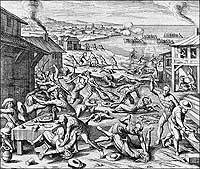
A member of deceased artist Theodore de Bry's family in Strasbourg executed this fanciful illustration of the first uprising in Strasbourg. Engraved before 1634, it depicted Jamestown, in the background, as a fortified, moated village.
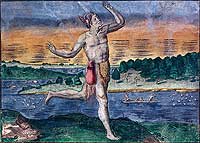
Historians once thought, but now doubt, that the murder of shaman Jack of the Feather triggered 1622's uprising. His appearance could have resembled this North Carolina native's, captured in the 1580s by Englishman John White.
But that summer Opechancanough made a mistake. He misjudged the loyalty of Esmy Shichans, the ruler of the Accomacks and the Occohannocks on the Eastern Shore—the peninsula across the Chesapeake Bay from Tidewater. Esmy Shichans had drifted away from Powhatan influence into a more comfortable relationship with the English. George Percy, the son of an English earl and twice governor of the Virginia colony, wrote that Opechancanough:
made strenuous efforts to obtain from another Indian king, whose land was very fertile in poisonous herbs, a large quantity of poison with the intention to therewith exterminate the English, but neither presents nor threats could induce this King to accede to the demands.The herb was probably water hemlock, or Cicuta maculata, a lethal plant abundant on the Eastern Shore. Esmy Shichans refused to send the poison and alerted Jamestown. Opechancanough could do nothing but deny the plot and bide his time until the colonists had let down their guard.
Some English chroniclers believed that the attack of 1622 was a direct response to the killing of Nemattanow, an important werowance, or perhaps a shaman, known to the English as Jack of the Feather. Wrote Percy: "He used to come into the felde all covered over with feathers and Swans wings fastened unto his showlders as thowghe he meante to flye." Nemattanow said magic made him immune from English bullets. That may have made him a little too bold in his dealings with the colonists. When he returned alone from a trading trip wearing the hat of the colonist who had accompanied him, Nemattanow was suspected of murder. He was seized by servants of the missing man, and shot.
"This occurence enraged King Opechankenough so that they say he swore to revenge the death of this Indian upon the English on the first favorable opportunity," Percy said. That echoes the belief of others, but he thought there was more to it than simple revenge for a single death.
My opinion is that their heathen priests, who are the tools of the devil, were constantly working upon the credulity and ignorance of this people to make them believe that the English had come to exterminate them in the same way as the Spaniard had done in other parts of the West Indies, and to prevent this the murderous attack was decided upon and brought into execution.
Although Percy scoffs at the idea that the English intended to exterminate the Virginia Indians, time would tell a different story.
Historians generally agree that the murder of Nemattanow was not the cause of the 1622 attack. It had been planned for early spring, long before Nemattanow's death. Food supplies were always lowest in the spring, but that year, Opechancanough knew, the English were desperately short of sustenance. Early spring was a good time to strike: Indian families, which dispersed each winter, were out of the reach of English retaliation, and planting time had not come. If the English were pushed back to Jamestown, the fields they had seized from the Indians could be reclaimed and sown in time for the growing season.
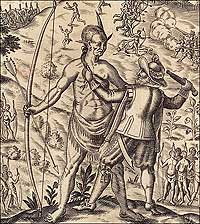
This contemporary representation of Opechancanough, taken from Captain John Smith's 1624 Generall Historie, is but an adaptation of White's 1580s watercolor of a North Carolina warrior, later engraved by de Bry.
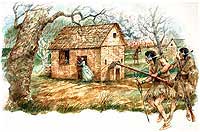
Painted to suggest a scene of the attack at Martin's Hundred in 1622, this illustration must approximate dramas played out at farms and homes scattered across Virginia's Tidewater that year, and again in 1644.
Thus Opechancanough timed his raid. He sent word of his plan by way of messengers on foot or by canoe. There was probably no village that lay farther than one day's travel from his central seat near modern West Point, at the head of York River. The protocol was described by colonist William Strachey in an early account of Jamestown.
When they intend any warrs ...a Weroance or some lusty fellow is appointed Captayne over a Nation or Regiment to be led forth, and when they would presse a number of Soldiers to be ready by a daie, an officer is dispatcht away, who coming into the Townes, or otherwise meeting such whome he hath order to warne, he strykes them over the back a sound blow with a bastinado, and byds them be ready to serve the great king, and tells them the Randivous, from whence they dare not at the tyme appointed be absent.Anthropologist Helen Rountree speculates that the "officer" would have directed warriors to the nearest English outpost: in this case, men from the Warraskoyack villages would be sent to attack Martin's Hundred, and Nansemond warriors would have been dispatched to settlements in what is now Newport News and Hampton.
"The tyme appointed" for the spring raid could have been the next day—indeed, historians know of an instance in which a messenger arrived in the evening to tell his brother to join the raid planned for the next morning. According to seventeenth-century chronicler Edward Waterhouse, Chanco, a Christianized Indian boy living with colonist Edward Pace across the river from Jamestown, was
urged by another Indian his Brother (who came the night before and lay with him) to kill Pace, (so commanded by their King as he declared) ...telling further that by such houre in the morning a number would come from divers places to finish the Execution.But most warriors would have required more than one night to prepare for the raid: to go through prewar rituals, stock up on arrows, and travel to the target. How did Opechancanough coordinate them?
More than one historian has suggested that the attacks were timed to coincide with the Christian Holy Week, thinking that the 1622 raid was on Good Friday. Eminent colonist George Thorpe had often conferred with Opechancanough on matters of religion, trying to convert the old chief to Christianity, and presumably would have shared with him the details of Easter and the resurrection. The Powhatans had a predilection for blending irony and warfare; these are Indians who killed colonists for stealing corn by stuffing corn down their throats. It is possible Opechancanough planned the attack for Good Friday to emphasize a rejection of the foreigner's religion.
Easter, however, does not cooperate with this theory, falling as it does on April 21 in 1622, weeks after the massacre. Easter came closer to the attack date in 1644—on the Thursday before Easter Sunday—but a raid timed for Maundy Thursday stretches credulity.
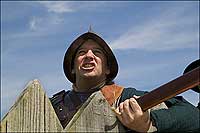
Warned of the impending assault in 1622, the soldiers of the fort at Jamestown—represented here by Colonial Williamsburg's Willie Balderson— stood to their guard and warded off the attack.
A late-nineteenth-century error moved the attack of 1644 back one day—to Good Friday—and confused that with the date of the 1622 attack. Memorable and catchy, the mistake persists in textbooks and on Internet sites despite the efforts of historians to correct it. Although no major religious holiday coincided with either attack, both did occur during the Easter season. Anthropologist Frederic Gleach believes the timing was intentional.
Could the raids of 1622 and 1644 have been coordinated with some celestial event? According to NASA charts, there were no solar or lunar eclipses within a month of either raid. Nor does the vernal equinox coincide with either date. In the Northern Hemisphere, the first day of spring falls near—but not on—the attack dates, coming two days before the 1622 raid and a month before 1644's.
Like most agrarian societies, the Powhatans recognized lunar months. "They reckon their time, by dayes and moons and years," wrote a clergyman in 1689, and lunar quarters were probably used as time markers by the Powhatans, as they were by the neighboring Delawares. Examining the phases of the moon for the dates in question—dates that require adjusting from the Julian calendar that English colonists used to today's modified Gregorian calendar used by NASA—an intriguing coincidence comes to light. The 1622 attack came one day shy of the third-quarter moon. So did the attack of 1644.
It could be just the one-in-twenty-eight chance of two events falling on the same day of the lunar month. More likely, the first date had no particular import, but Opechancanough patterned the 1644 surprise attack after 1622's, using the same lunar date that brought him success the first time. It seems unlikely that something so important would be timed solely by a visual sighting of the moon. What if spring rain clouds obscured the moon for a week? But the Powhatans were perfectly capable of counting the days between quarter moons. According to Captain John Smith, they had a numbering system that used specific numbers from one to ten, after which "they count no more but by tennes" to reach one hundred. When necessary, they used devices such as notched sticks and knotted string to track larger numbers. The notched stick method would not have been necessary for small numbers such as the number of days to count before launching the attack.
It is also possible that the day before the third quarter of the moon had some specific connotation. Queries of today's Virginia Indian leaders received the polite reply that discussing this sort of spiritual cultural knowledge is inappropriate outside the Indian community.
However he managed it, Opechancanough twice set the date for a massive assault on multiple English settlements and twice sent word to his people. Everyone got the message. No one attacked a day early or a day late.
Interactive Flash Feature (Flash required).
Captain John Smith's Capture and Rescue as depicted in his 1624 illustration.
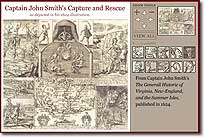
Suggestions for further reading:
